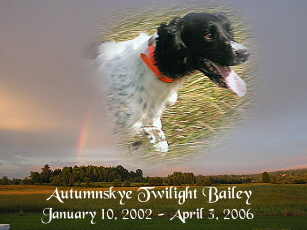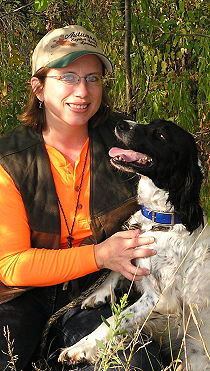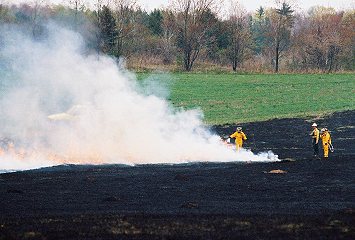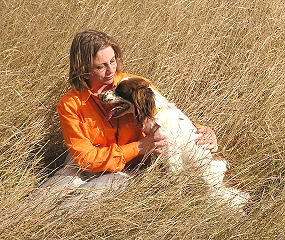

I had gone out to the kennel right after sunrise that morning in early April to let the crated dogs out, as I always do - even before getting myself a cup of coffee. Bailey wasn't moving. Normally, her face would be pressed to the grate watching my every move, eagerly awaiting her turn to be released. She always insisted on a good cuddle - even before attending to her needs.
Alarmed, I thought that she was dead. But then, I saw her eye move. I couldn’t get her to come out, so I went back to the house to get Steve. He helped her out of the crate, but she didn't seem able to move. It was almost as if she was becoming paralyzed! We got her outside and she relieved herself, then brought her to the house, called the vet and took her in. Her heart was thumping hard and her head quivered with each beat. Her eyes looked awful and she would not move. We didn’t know if we would even make it to the clinic in time.
They drew blood to check for heart worm, lyme and erlichilosis. She had that - erlichliosis - about three years ago. Test results were negative. They did other blood tests and the vet examined her. Despite the veterinarian clinic’s efforts to save Bailey, she didn’t make it. The potent neurotoxin paralyzed, caused seizures and eventually reached the part of her brain that controls breathing.
She was fine when I took her out to the pond for some water retrieves. It was a casual walk in the field - both of us enjoying a beautiful, warm spring day and each other’s company. I often said that my field bred English springer spaniel, Autumnskye Twilight Bailey, could win a dog show. She was absolutely beautiful. She didn’t walk… she pranced, like a race horse. Bailey was a fun-loving girl with a sweet personality. In the field, she exhibited a fantastic wet or dry nose, handled beautifully, was speedy, graceful, agile and an energetic dynamo. Inside, she was calm, enjoyed being with people, well-behaved and just was a real joy to be around. Bailey was intelligent, a quick-learner, enthusiastic, and always willing to please.
"Algae in July... yes, but at the beginning of April, just a day after the ice melted from the water’s surface? Yes, again."
I had some of the younger dogs down to the pond earlier that afternoon. It was one of the first warm days of the season. The sun was shining and the breeze was ever so slight. Not even a ripple appeared on the surface of the water. Our pond is seasonal. It only holds water during the spring - mostly the snow melt and rain. There is a lot of standing dry grass and it attracts all sorts of returning migrating birds: ducks, Canada geese, sand hill cranes and whistler swans. The younger dog lost track of the dummy’s location, enticed away by so much fresh bird scent. So, I brought along a pocket of stones, hoping I’d be able to plunk one out far enough for Bailey to locate the dummy. She did it with style and a picture perfect delivery to hand, as always. Ever eager to please and do what I asked of her described my girl.
The vet said he believed she was poisoned by toxic blue-green algae. He did an autopsy and said what he saw was consistent with the diagnosis.
I had thought algae was only a problem in the hot summer months. I wouldn’t dream of send my dog into stagnant, slimy algae-infested water. I could not see any sign of algae in our pond, so it never crossed my mind that there could be a problem... or a danger. Algae in July... yes, but at the beginning of April, just a day after the ice melted from the water’s surface? Yes, again. It can bloom as soon as the ice is off the water. As temperatures warm, the ice layer thins, acting like a magnifying glass - which can lead to an algae bloom.
Thank God, none of the other dogs got sick.
What are blue-green algae?
They really aren’t algae at all. However, like algae, they do use photosynthesis. Actually, the organisms are a type of bacteria called "cyanbacteria".
There are many varieties of blue-greens including several that produce toxins. The two primary types of toxins are: hepatoxins and neurotoxins. Hepatoxins damage liver and other internal organs. They may also cause gastroenteritis, nausea, vomiting, muscle weakness and problems with vision. Neurotoxins act as neuromuscular blocking agents leading to paralysis and respiratory arrest. According to the World Health Organization, "The neurotoxins, such as anatoxin-a and -a(s), are highly toxic nerve poisons but have short biological half-lives. on acute exposure, the neurotoxins cause death within minutes to a few hours, depending on the species, the amount of toxin ingested and the amount of food in the stomach."
How did it get in our little pond?
Most likely, the toxic strains of algae arrived at our small, ephemeral pond on the feet of migrating birds. Algae thrive in water with high nutrient and phosphorus levels. Agricultural run off contains these elements.
Our back field and the neighboring property form a bowl - with drainage into this seasonal pond. There is no outlet or supply of fresh water source. The elderly man who owns the adjoining property allows a local dairy farmer to lease the property to cut hay. The farmer has had numerous tanker trucks spew black sludge from his liquid manure tank on this field three times during the eight years which we've lived here. He does this in November, always during deer hunting season - then leaves it until May or June, when he finally tills the soil. Unfortunately, our property is at a lower elevation and it runs onto our land, doing his field no good whatsoever. On years when that happens, I do not allow the dogs on the back field or near the pond until it is dried up - usually in June. I had thought this was a "safe" year.
Sadly, I was not aware of toxic blue-greens and the role agricultural run off plays in creating a hospitable environment in a pond for these deadly organisms.
After loosing Bailey, we contacted the Wisconsin Department of Natural Resources and had water samples taken, first on April 7th, then again on May 24th. Toxic blue-greens were found at each testing. At the time of the second water sampling, there was little more than three or four shallow pools remaining - yet, toxic blue-green was still present. Results identified over a dozen species of algae - among which they found two that can - and do - produce toxins: Oscillatoria, a Planktothrix species, and Chroococcus. US websites seem to imply that it is believed that Chroococcus is not a toxic strain, however, there also is an admission that not much is known about toxic blue-greens, in general.
I located a paper on the EPA's website written by researchers at the Cyanobacteria and Astrobiology Research Laboratory School of Biotechnology and Biomolecular Sciences, The University of New South Wales, Sydney Australia, which does identify this species among those identified as being toxic. The DNR was surprised to find that strain in Northern Wisconsin. Nutrient and phosphorous levels in our water samples were determined to be "higher than in most lakes" the DNR reported - which is not surprising.
On April 29th, we had our local volunteer fire department and a fire crew from the DNR do a controlled burn on our field surrounding the pond. Even after infested water is dried, toxic residue can contaminate the grass and weeds. Dealing with the pond - attempting to clean it up and avoid future risk - is a more complicated issue. Without the cooperation of our neighbor and the leasing farmer contamination of our property and further infestations of toxic blue-greens will be an ongoing issue. However, if necessary, we will pursue legal means.
How can I be sure a body of water is safe for my dog?
According to Australian authorities, "The only way to determine if an algal bloom is toxic is through microscopic examination and toxicity testing by an approved laboratory."
Toxic algae blooms are a world-wide problem - not just specific to ponds or lakes. In 1991 the world‘s largest recorded outbreak occurred in Australia's Barwon-Darling river system - stretching for 1000km. Avoiding bodies of water with visible algae, a source of septic tank, sewer leakage or agricultural runoff contamination and calm, windless days is advised. However, in our case, there was no visible sign of algae. The toxic blue-greens often grow beneath the surface of the water... unseen.
On the day we lost Bailey, I spoke to a firefighter friend of ours who told me they've just issued an alert that toxic blue-green algae is showing up in a lot of lakes and bodies of water in Northern Wisconsin. Before that day, I'd never even heard of it.
|
|
| Bookstore | Bill Fawcett Reviews | Advertise | Classifieds | Resources | Events | Point Standings | Archives | Spaniel Journal | |
|
|
Copyright © Spaniel Journal & L Baughan Webdesign, 2002-2006, all rights reserved worldwide |
|



